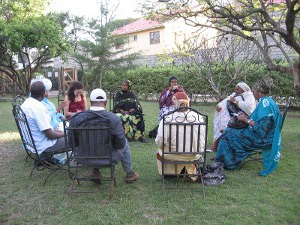 Haney Mussa, a Somali-Canadian living in Toronto and a former student of mine, spoke in class one day, describing the importance of storytelling in the traditional culture of her homeland.
Haney Mussa, a Somali-Canadian living in Toronto and a former student of mine, spoke in class one day, describing the importance of storytelling in the traditional culture of her homeland.
Haney’s grandmother, a revered storyteller in the community, used a simple but effective way of revealing the connections between people. Everyone would gather around the fire in the evening to share their personal stories, with the speaker holding a ball of yarn. As each speaker finished, the ball would be passed to someone whose story connected to the last one, while the speaker held onto the thread. By the end of the evening, the patterns created by the strands of yarn gave a graphic picture of the relationships within the group.
Inspired by this simple, yet evocative, image I applied this technique on several occasions — for the last class of the Community Healing and Peacebuilding course I teach and when the InterChange Toronto group used it for a memorable evening of telling personal stories amongst ourselves (which we called “Web of Connections”).
So when Jennifer Ball and I were planning a module on trauma healing as part of the PHARP training on “Indigenous, Biblical and Modern Approaches to Conflict Transformation”, held in Nairobi, Kenya, in July 2009, we decided to end the module with a similar personal storytelling activity.
There’s not much preparation needed — just set up a circle of chairs and bring a ball of yarn. In Nairobi we decided to hold our activity out in the garden. There was a buzz of anticipation as members of the group took their places on the heavy metal lawn furniture.
The group had already discussed storytelling and its role in peacebuilding and we felt confident that everyone understood the activity. I began by describing the circle we’d held in Toronto and reiterating the importance of storytelling in healing and peacebuilding. Each person was then invited to tell their own story, and the ball of yarn was placed in the centre of the circle to be taken up by the first person to speak.
However, as the first and then the second participant told animal stories, which are common in the African context, we realized that we had made the assumption that there was a common understanding among the group. In fact, there are many different cultural understandings about the use of the term and concept of stories.
One of the participants voiced what others were feeling: that this somehow didn’t sound like what those leading the activity were anticipating. This allowed us to clarify that we wanted people to share their own personal stories. We were then able to take up the activity as envisaged.
Just as had happened in Toronto, no one knew what they were going to say until they started speaking. As each person ended their story, another participant in the circle was ready to take up the yarn because there was no difficulty seeing the deeper connections between the stories.
The two participants who had told allegorical stories at the beginning were eager to tell their own personal stories and the activity ended as it had in Toronto —with the web of yarn reminding us of the deeper connections between everyone.
The title for this article can be understood at several different levels. A “web of connections”, an activity originally held in Toronto, was replicated in Nairobi. However, the idea was sparked by someone we have never met, across time and space.

Recent Comments